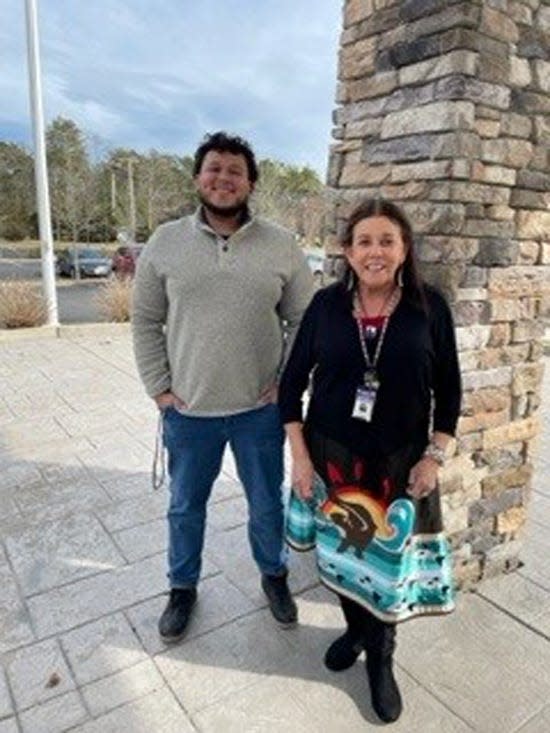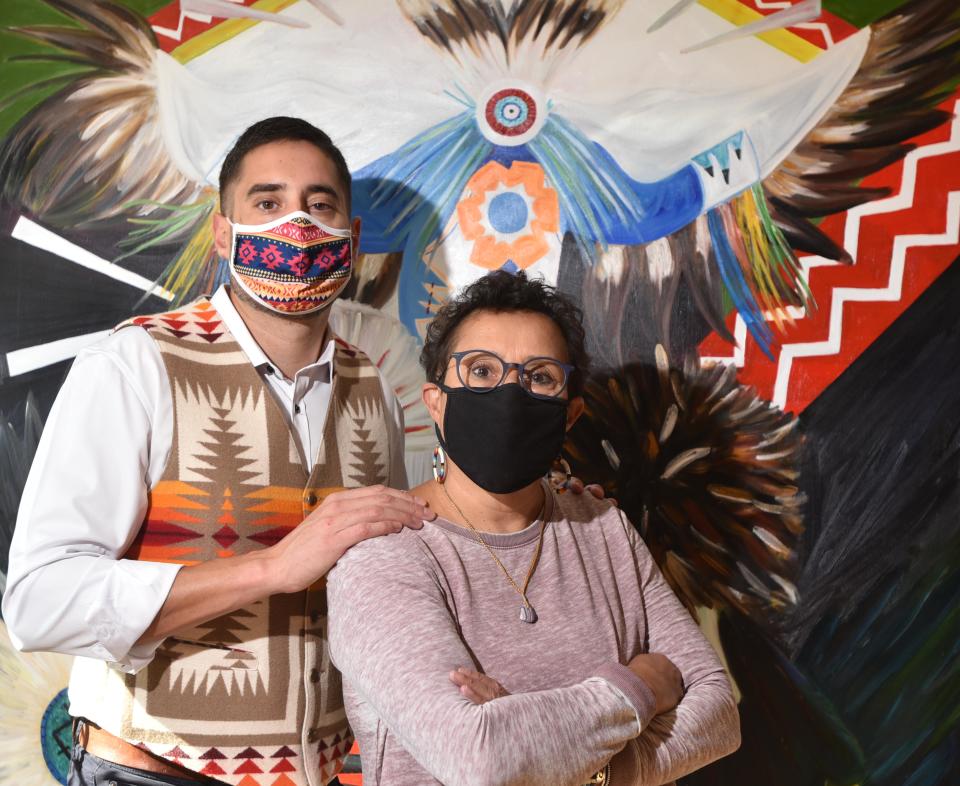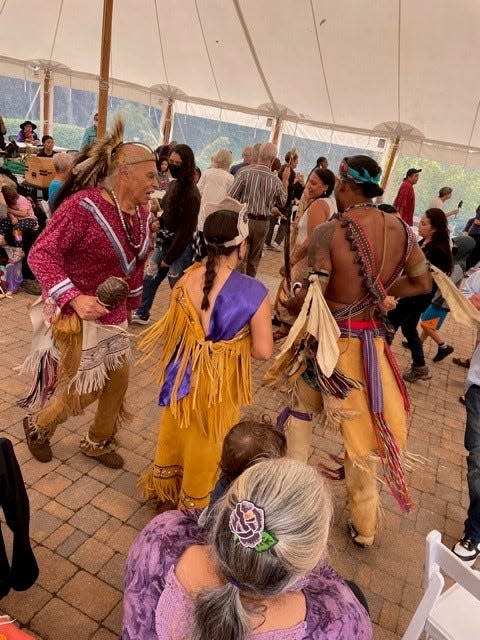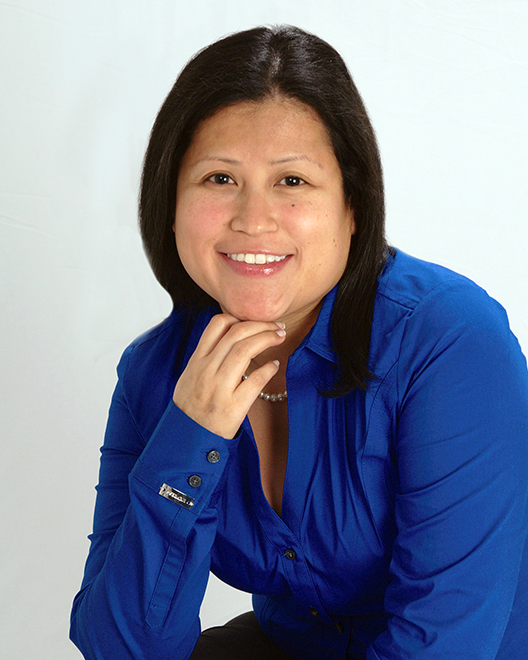Cultural event aims to open dialog between non-Native and tribal members in Falmouth
FALMOUTH — Gertrude "Kitty" Hendricks-Miller said Wampanoag tribal members don't need to sit in a wetu, dressed in 17th-century clothing to teach the wider community about Wampanoag culture.
"Even if we are sitting in jeans and T-shirts we hold traditional values and walk in two different worlds," said Hendricks-Miller, Indian education coordinator for the Mashpee Wampanoag Tribe. "We keep our identity as tribal people as we live in a modern world."
Part of straddling traditional Wampanoag culture and present-day American living, said Hendricks-Miller, is educating the wider community.
Which is why Hendricks-Miller, along with Highfield Hall & Gardens, and the Rotary Club of Falmouth, plans to host the second annual Wampanoag Cultural Celebration from 11 a.m. to 4 p.m., Sunday at Highfield Hall.
Because the educational festival aims to raise awareness about the culture and history of local Native American tribes, the event will feature hands-on activities such as making corn husk dolls, rattles, and clay beads making — pre-contact tribal arts that aren't always taught to non-Native communities.
A diorama created by Anita "Mother Bear" Peters will also be on hand, as well as a wampum community belt, which traveled to a myriad of tribal educational events throughout the United States, as well as England.
Medicine man Earl Guy Cash or "Soaring Eagle," is expected to give a blessing at the event; and Amiyah Peters, Mashpee Wampanoag Powwow princess, is scheduled to speak throughout the day.
As each activity is conducted, Hendricks-Miller said face-to-face conversations will be held, to give the public an idea of life before colonization, and colonial settlement.
"It was a simple time — uncomplicated," she said.

More: Here's the story behind the chair on Brewster's town seal. Is it time for a change?
Children then refined their fine motor skills through jewelry making and everyday life, Hendricks-Miller said.
"We had time to make things beautiful because of our lifestyle," she said. "We didn't go out and work for other people."
King Philip's War exhibit also makes debut
The event will also coincide with the opening of the "King Philip's War" historical exhibit at Highfield Hall, which runs through Monday, Oct. 10.
The display was curated and designed by Steven Peters, head of branding and creative development at Smoke Sygnals, a multi-media company, and is comprised of large-scale, cedar-framed panels featuring images and text surrounding King Philip's War.
The conflict, which occurred between the New England Confederation and the Wampanoag, Nipmuck, Pocumtuck and Narragansett tribes, was ongoing for about three years, but included 18 months of intense direct combat that began in 1675, Peters said.
The exhibit will give people an introduction to King Philip's War itself, he said, but will also address issues that caused the war.
"There’s not nearly enough attention given to a war that shapes the world as it is today," Peters said.
Much of the information composed in the exhibit comes from text left behind by John Easton, the only Pilgrim who documented the grievances the Wampanoag had throughout the early days of colonization.
More: First Light Shellfish Farm brings economic sustainability to Mashpee Wampanoag Tribe
"The texts were gathered by John Easton from Metacom, who was known as King Philip by the English," Peters said. "It's an interesting dialog that explores if the war could have been avoided."

The display is also expected to focus on the land throughout Cape Cod that was quickly divided once the war ended and will feature maps from 1630 that depict villages, natural resources, and open land before the conflict. Another map depicting 1730 shows the land completely colonized, he said.
"The exhibit is small, but packed with information," Peters said. "But it's also emotional to really visualize what was lost during that war."
For Tara Burke, co-executive director of Highfield Hall, King Philip's War lasted for only a short time, but resulted in a greater loss of life than the Civil War based on area populations of that time period.
"It was a brutal war and sad for both sides," she said. "The transfer of land and property afterwards has always been a very contentious thing and the exhibit includes sad commentary on the push and pull of colonialists and how they integrated into an existing society."
By showing the exhibit for a week after the Wampanoag Cultural Celebration, Burke said the display has the potential to teach many others who can't make it to the opening.
"We hope people will come and learn," she said. "There’s so much to this story."

Wampanoag connection to land goes beyond Mashpee
Throughout the creation of the panel exhibit, Peters said he also wanted to highlight the connection of the Beebe family to King Philip's War. While it was the Beebe Family who created the Highfield Hall estate, members of the family also fought in the war.
More: Smithsonian video series spotlights Wampanoags and locally made wampum belt
"The first Beebe immigrated to the United States in 1650," he said. "Because a few of the Beebe's fought in King Philip's War, we wanted to also tie the exhibit to the land and its history, which shows a connection to the Wampanoag Tribe."
While ongoing research is being conducted surrounding the Beebe's connection to King Philip's War, Burke said there were many ways that land was transferred to colonial hands after the war concluded.
"We haven't found evidence yet of how Beebe Woods was transferred, but we did make a connection that some of the Beebe descendants did fight in King Philip's War," she said. "There were nefarious reasons that colonists obtained land — sometimes land was even given by the King of England."
For 30 years, Hendricks-Miller lived in Falmouth off of Sippewissett Road and felt a close connection to Beebe Woods, a 383-acre plot named for the Beebe family. The land was given to the town of Falmouth in 1972 by Mr. and Mrs. Josiah K. Lilly III., according to the Highfield Hall website.
More: What is Indigenous tattooing? In New Bedford, and Denmark, women artists revive the practice
Beebe Woods, along with the Highfield Hall estate is sacred land, Hendricks-Miller said.
"That was a spot where our people performed ceremony because of how high it is. It's close to the Creator," she said. "We have always been drawn to that place."
Despite that history, there was a time when non-Native people in Falmouth and Mashpee were afraid they would lose their land as the Wampanoag Tribe fought to obtain their ancestral homelands in the 1970s, Hendricks-Miller said.
"For a long time people were afraid and they didn't want us or our culture in their back yard," she said. "But here we are. This exhibit and event serves as a timely homecoming in Falmouth."
Tribal and non-Native collaboration leads to learning
Throughout the years, Hendricks-Miller said, the greater Cape community has become more open to cultural programming.
"People aren't so afraid anymore," she said. "I think equity and diversity is very much on people's conscience."

Amy Caspersen Wyman, founder of Good Grief Cape Cod and a co-founder of "Wampanoag Cultural Celebration," said the event is geared towards non-indigenous people to raise awareness about the presence of Wampanoag people throughout the region.
More: Barnstable County Human Rights Advisory Commission seeks volunteers
What's equally important, said Caspersen Wyman, who is of the Chibcha nation, also known as the Muisca people of Colombia, is the multi-cultural efforts that came together to create the Wampanoag Cultural Celebration.
"South American, and North American tribal people came together to provide education for the community about indigenous lands," she said. "The knowledge and history that will be brought to this event has greatly impacted all of us on a spectrum of levels."
For Hendricks-Miller, the event has shown a willingness from all sections of the community to learn the true history of the past.
"This event is a tribal snapshot of us as a community," she said. "It's taking on wings of its own and it's a total and complete package for families."
Contact Rachael Devaney at rdevaney@capecodonline.com. Follow her on Twitter: @RachaelDevaney.
This article originally appeared on Cape Cod Times: Falmouth cultural event aims to open dialog between non-Native and tribal members

